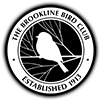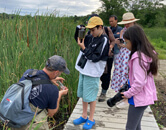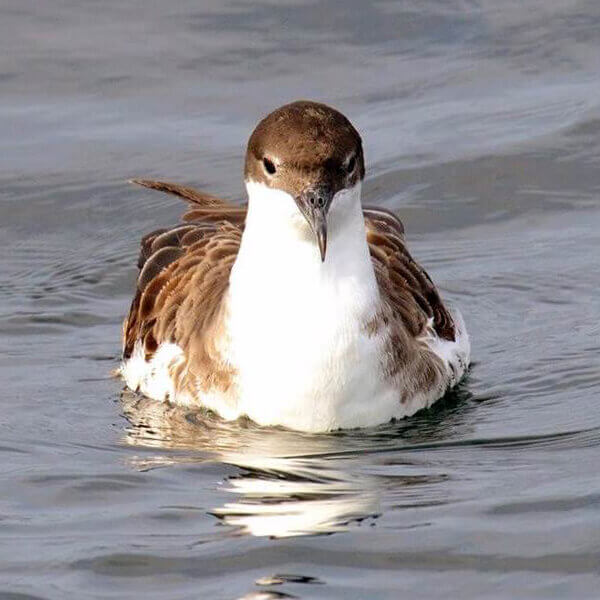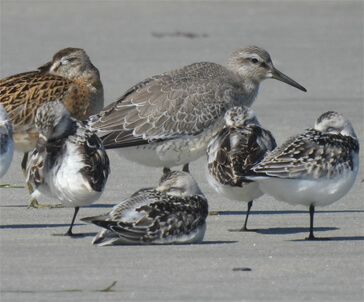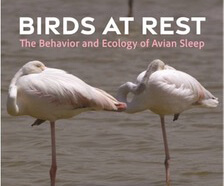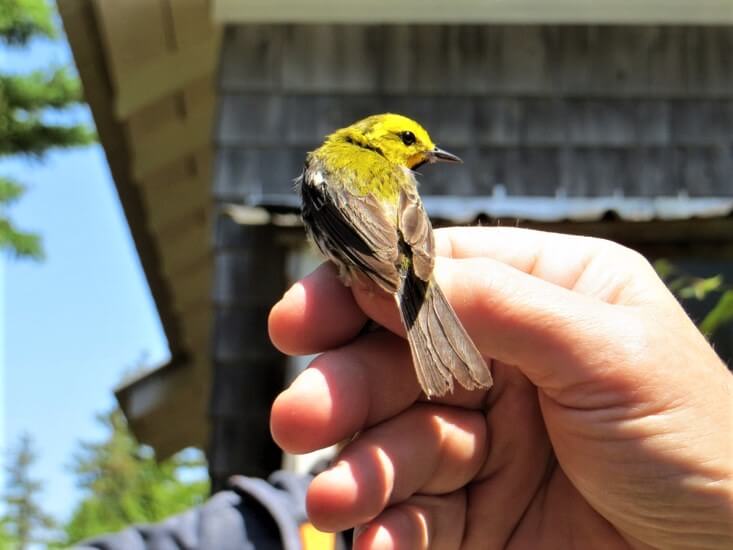2011 STATISTICAL AND YEAR-END REPORT
Robert H. Stymeist, Statistician
During 2011, the Brookline Bird Club listed 302 species of birds on 197 reported trips, three more than last year. A total of 224 trips were scheduled,twomore than last year but 66 fewertrips than the all-time high number of 290 in 2000. There were 49 all-day, 144 morning, 18 afternoon or evening, ten pelagic, and three weekend trips. There were also two impromptu trips organized for reported rare birds–one was successful in adding a new species to the overall Club’s list.
On May 18 Ida Giriunas led a small group to search for the FIRST state record of Cassin’s Sparrow. The normal range for this sparrow is in the western United States grasslands. The sparrow arrived during a period of northeast winds and remained in the area for five days. Ida and her team added this to the overall Club list with a day to spare before it disappeared. Sylvia Martin, on the other hand, was a day late when on April 19 she led an impromptu trip to Hyannis in search of just the second state record of a Yellow-legged Gull.
Thirteen trips were not reported, and an additional 13 trips were cancelled by weather. In Massachusetts the Club listed a total of 291species, three more than last year. To put this in perspective, birders throughout the state recorded a total of 363 species during the year; thus the BBC total of 291 is 80% of all the species seen in the state in 2011!
Two new species were added to the overall Brookline Bird Club list of birds, a Cassin’s Sparrow that was discovered on the impromptu trip on May 18, and a Brown Booby from Provincetown on day three of the Cape Cod Blitz weekend led by Bob Stymeist. The Brown Booby, just the fifth record for Massachusetts, was discovered on August 16 in Dennis and then moved to Provincetown, where it remained until mid-December.
Missing from the Club list in 2011 were Tricolored Heron, Marbled Godwit, Black Skimmer, Snowy Owl, Long-eared Owl, Northern Saw-whet Owl, Common Nighthawk, Acadian Flycatcher, Gray-cheeked Thrush, Golden-winged Warbler, and Clay-colored Sparrow. Three other species, Black-legged Kittiwake, Arctic Tern, and Nelson’s Sparrow, were not seen on any Massachusetts trip but were recorded in Maine. These three species have been routinely found on our Mass lists in most years. Our trips to Maine also added the following species not recorded in Massachusetts: Spruce Grouse, Atlantic Puffin, Bicknell’s Thrush, Black-backed Woodpecker, Gray Jay, and Boreal Chickadee.
The Club visited Essex County most often, with a total of 73 trips (35 to the Newburyport and Plum Island area, 27 to Cape Ann as well as three trips to Marblehead Neck Wildlife Sanctuary, four trips to Ipswich, two to Nahant, and visits to Boxford, Manchester and Salem). The trips in Essex County accounted for 225 species, which is 77% of all the birds reported on Club trips. Mount Auburn Cemetery in Cambridge was second with 29 trips, two less than last year; at Mt. Auburn the Club recorded 27 species of warblers and on April 30 three Sandhill Cranes circled the cemetery, a first record! There were 27 trips scheduled in the Metropolitan Boston area. Thirty-five trips to Cape Cod and the South Shore recorded 241 species, surpassing Essex County for the first time in Club history for the total number of birds overall from an area; this is an amazing 83% of all the birds reported on Club trips in 2011. There were 27 trips in the Sudbury River Valley area, which includes Great Meadows NWR, Oxbow NWR, and the Assabet NWR and five trips to areas in western Massachusetts. There were ten pelagic trips scheduled including three new trips out of Boston led by Naeem Yusuff. Only two of the four extreme pelagic trips were able to venture out to sea. Hurricane Irene cancelled the August trip and the heavy seas following the hurricane cancelled the make-up days. Rounding out the schedule were three trips in search of Woodcock, the annual Owl Prowl and the Cape Cod Waterfowl Census, and several new kayaking trips organized by Diana Fruguglietti and Paul Ippolito.
Out-of-state trips included weekend trips to the Machias area and to the Highland Plantation and Rangeley Lakes region in Maine. The combined total number of species on the Maine trips was 131and included boreal birds such as Spruce Grouse, Black-backed Woodpecker, Gray Jay,Boreal Chickadee,andBicknell’s Thrush. Other species that were noted in Maine but not on any BBC trip in Massachusetts included Black-legged Kittiwake, Arctic Tern, Atlantic Puffin, and Nelson’s Sparrow. Ida Giriunas led her 29th annual Club trip to the Machias area, which includes the famous Machias Seal Island, and recorded over 6,000 Atlantic Puffins! Ida and Eddie Giles have been leading these great trips for many years, affording Club members the opportunity to see some northern forest and ocean birds that don’t nest in Massachusetts. There was just one trip scheduled in New Hampshire. On November 6 Steve and Jane Mirick led their annual early winter trip along the coast; 30 members shared Steve’s favorite birding spots in New Hampshire, including Great Bay, where three male Eurasian Wigeons were seen. Several of the participants continued on to West Newbury, Massachusetts, and saw the Barnacle Goose that was first found early that day.
The Massachusetts Audubon Society (MAS) Checklist (07/2010) now includes most of the species that have been identified in the state as determined by the Massachusetts Avian Records Committee (MARC). The Club recorded the following species that are listed as review species that the records committee is especially interested in as well as some species that are less than annual in occurrence.
Barnacle Goose Acton November 6
Brown Booby Provincetown September 18
Cassin’s Sparrow Truro May 18
Highlights from the 2011 Brookline Bird Club Year
The Spring Meeting at the Harvard Museum of Natural History on April 15 featured Julie Ellis, who presented a fascinating account of two of our common gulls, the Herring and Great Blacked-backed, and how they react together in coastal environments. The guest speaker at the fall lecture meeting at Harvard in October was Jerry Bertrand, the former president of Mass Audubon, who discussed ways Birdlife International is helping to save some of the world’s species that are threatened or endangered. Our Winter Meeting on February 25 at the Bedford Middle School featured many of our Club’s members sharing their birding trips and photographs.
Laura de la Flor and Mark Burns started 2011 off by leading their 15th annual New Year’s Day birding trip. Thirty members enjoyed a perfect day of birding; the temperature reached a balmy 55 by afternoon. After a welcoming toast of sparkling apple cider the group got down to birding and tallied a nice list of 56 species to start off the year. January 2011 was the third snowiest on record, yet our Club leaders recorded an amazing 112 species on just 18 trips during the month.
Eddie Giles and Mark Burns led the 13th Annual Owl Prowl on January 22. The trip is an attempt to find by sight or sound all seven species of owls wintering in the state, excluding the offshore islands of Nantucket and the Vineyard. The group found ten individual owls of only three species. Eddie teamed up with Mary Kelleher on March 13 to lead the Club’s third Waterfowl Prowl. Like the owl prowl, the intent is to locate as many as possible of the 29 species of ducks in one day on Massachusetts ponds. The leaders tallied 24 species of ducks including Eurasian Wigeon and Northern Shoveler.
The Club scheduled Woodcock walks in Stoughton, Reading, and the Blue Hills. The Club continued co-sponsoring the TASL (Take a Second Look) surveys of the waterfowl of Boston Harbor and a Dawn Heron Census at Belle Isle Marsh in East Boston. Ongoing was a series of mid-week trips on Cape Ann in search of alcids led by Barbara Volkle. Glenn d’Entremont led the weekend jaunt out in the Berkshires birding Mount Greylock and October Mountain and recorded one of the only two Northern Goshawks and the only Cliff Swallows on a Massachusetts list.
Of the ten pelagic trips scheduled (three out of Boston, two out of Gloucester, one out of Newburyport and four “extreme” pelagics out of Hyannis), two of the popular offshore trips were cancelled because of weather. The June trip to Nantucket Shoals featured the impressive number of over 1,300 Sooty Shearwaters and great looks at both Parasitic and Pomarine Jaegers. The birders on board got a quick glimpse of a skua that vanished into the fog and could not be identified. The July trip to the canyons of the Continental Shelf was most memorable for the shark sightings; a Whale Shark, which Steve Mirick excitedly announced over the microphone, was the highlight of the trip, which also recorded a Tiger Shark, 2 Basking Sharks, and a Loggerhead Sea Turtle.
Summer trips were highlighted by evening trips to Plum Island searching for early migrating shorebirds and flocks of herons flying to roost. On an evening trip on August 8 the Club counted 138 Snowy Egrets before heavy rain started to fall. Eleven members joined Laura de la Flor and Mark Burns on the annual Hawaiian Shirt Shorebird Safari to South Beach; highlights were 17 shorebirds species and just offshore over 1,000 Wilson’s Storm-Petrels and three very obliging Parasitic Jaegers. The Club initiated its first kayak trip in August on the Nashua River; 17 people in 16 boats traversed the river from Lancaster to Still River and recorded 39 species. A second kayak trip paddled the Squanacook River in Groton, so watch for more kayak trips in 2012. The fall migration started off with a three-day Cape Cod Blitz hitting the hot spots on the outer Cape from Chatham to Provincetown. A total of 114 species were seen including the first record of Brown Booby for the overall Club list. Also noted during this sweep were five Philadelphia Vireos, the year’s only Olive-sided Flycatcher, and 15 species of warblers. A hawk watch on Mt. Tom saw 169 migrating Broad-wings and only the second Northern Goshawk on the Club list for the year. October brings the sparrows and frequent visits to community gardens in Wayland and Newton as well as the sparrow meccas of Cumberland Farms and Bolton Flats. At Cumbies on October 9 the Club recorded seven species of sparrows, a Dickcissel, a calling and circling Sandhill Crane, and a White-winged Widowbird, alas an escape but a very nifty-looking bird.
November and December found our members visiting Cape Ann with four trips, one of which was extended to West Newbury when word got out of a Barnacle Goose, just the second time that this species was seen by the Club (the first was in 2010). A trip to Fairhaven in early November recorded 83 species, which included great looks at Orange-crowned Warbler and Yellow-breasted Chat.
At the end of the year the Club suspends scheduled trips so that our members can participate in the Christmas Bird Counts (CBC). There are 34 count circles in Massachusetts.
A total of 50 leaders guided our members around the state throughout the year. All of our dedicated leaders deserve a special thank-you including several leaders that deserve recognition for not only many years of leading but the number of trips each year they lead: Ida Giriunas, the Energizer bunny, led the most with 19 trips, followed by Bill Drummond and Linda Ferraresso with 15, then Glenn d’Entremont with 14, Jonathan Center and, Bob Stymeist with 13, Peter Van Demark with 11, and Eddie Giles with 10. Another 13 dedicated leaders accounted for five or more trips each. The club welcomed first-time trip leader Jim McCoy.
The club’s cooperation with and outreach to organizations with similar interests led to co-sponsorships of BBC trips by the following: South Shore Bird Club, Woburn Residents Environmental Network, Athol Bird and Nature Club, Nahant Open Space Committee, Essex County Ornithological Club, Assabet River NWR, the Merrimac and Ipswich River Watershed Councils, Trustees of Reservations, Halibut Point State Park, Boston Nature Center, Menotomy Bird Club, Forest Hills Educational Trust, Arboretum Park Conservancy, Take a Second Look, the Frederick Law Olmstead National Historic Site, and the Waquoit Bay National Estuarine Research Reserve.
The biggest trip list this year was Glenn d’Entremont’s South Shore Century Run, recording 117 species on May 7. This trip, entirely in locations in Plymouth County, recorded the only Upland Sandpipers and Vesper Sparrows seen by the club in Massachusetts in 2011. Other highlights on this long day were 15 species of warblers including Cerulean and Worm-eating.
In the following table you can see which trip in each month recorded the most species; this may help in planning for a big year of birding.
January 8 Westport 78 species Bob Stymeist, leader
February 6 Scituate-Plymouth 66 species Glenn d’Entremont, leader
March 19 C. Cod-Cumb.Farms 59 species Laura de la Flor, leader
April 24 Suffolk County 76 species Bob Stymeist, leader
May 7 S.S. Century Run 117 species Glenn d’Entremont, leader
June 19 October Mountain 74 species Glenn d’Entremont, leader
July 11 Plum Island 63 species Tom Young, leader
August 13 So. Beach, Chatham 67 species Mark Burns, leader
Sept. 17 Wellfleet 89 species Bob Stymeist, leader
October 8 Outer Cape Cod 107 species Glenn d’Entremont, leader
November 5 Fairhaven 83 species Bob Stymeist, leader
December 17 Cape Ann 46 species Bob Petersen, leader
The Club recorded nearly 80% of all the birds that were noted during 2011–pretty impressive! A total of at least 363 species were observed and reported by birders across the state. TWO new birds were added to the official state list: Yellow-green Vireo and Cassin’s Sparrow Impressive species seen during the year not recorded on BBC trip lists were Black-bellied Whistling Duck, Pink-footed Goose, Ross’s Goose, Tundra Swan, Tufted Duck, Western Grebe, White-tailed Tropicbird, Wood Stork, Magnificent Frigatebird, American White Pelican, Brown Pelican, Little Egret, White Ibis, White-faced Ibis, Swallow-tailed and Mississippi kites, Eurasian Hobby, Purple Gallinule, Wilson’s Plover, Black-necked Stilt, Sooty Tern, White-winged Dove, Ash-throated Flycatcher, Cassin’s Kingbird, Scissor-tailed Flycatcher, Yellow-green Vireo, Northern Wheatear, Townsend’s Warbler, Lark Bunting, Western Tanager, Painted Bunting, and Hoary Redpoll.
Weather-wise 2011 was 1.9 degrees warmer than normal, tying with 1991 as the fourth-warmest year on record. January saw record snowfall, nearly 39 inches in Boston alone. March brought record warm temperatures–70 degrees on March 18 in Boston was a record high, and April also saw very warm temperatures, which advanced the foliage before migration got into high gear. The summer was a mixed bag. June was unusually cool, which was probably good for our breeding birds, and July and August had above-normal temperatures. September and October were very pleasant, great birding weather, and November and December had record warm days with many birds lingering well their beyond normal departure dates.
2011 Annual lists
The Brown Booby was the clear-cut favorite; this was just the fifth record for Massachusetts and the first of its kind to stick around for everyone to see. The bird was first noted at Corporation Beach in Dennis, where it lingered for a week and then reappeared in Provincetown, where it continued into mid-December! The Cassin’s Sparrow–a first record for the state–was also mentioned despite its drab appearance. Yet another bird named after John Cassin (1813-1869), a curator of ornithology at the Academy of Natural Sciences in Philadelphia, garnered a few votes: the Cassin’s Kingbird that was discovered late in the year in West Newbury.
It was a very noteworthy fall for vagrant flycatchers in addition to the Cassin’s Kingbird; others mentioned the unprecedented numbers of Ash-throated Flycatchers that were seen as well as a few Western Kingbirds. Birders got incredible looks at two rare rails, a Clapper at Allen’s Pond and a King at Belle Isle marsh in East Boston.
There were many favorite birds that had been drawn to feeders, some hosted by BBC members. The Townsend’s Warbler that showed up on Christmas Day at Jim Berry’s home continued into the new year. Linda Nachtrab kept a watchful eye on a Red-headed Woodpecker at her feeder in Maynard that several birders mentioned as their favorite. Another great feeder visitor was a female Painted Bunting in Eastham.
There were personal moments such as a walk down Crane Beach in Ipswich, where three Snowy Owls were all “picture perfect” sitting on top of the dunes. Other serendipitous occasions: zipping along the Plum Island turnpike hoping to get to Stage Island to see a reported White Ibis when out of the corner of my eye I spotted a bird of interest–wow, a White Ibis—what luck! Taking a leisurely bike ride in Chatham and looking up to find a Swallow-tailed Kite, then finding out that another birder saw it minutes later. Finding two pair of Great Horned Owls on nests in your own birding area, or seeing Razorbills close to shore on Cape Cod.
Having your best bird turn into something else better; a Royal Tern became an Elegant Tern, which proved to be a very valuable learning experience for many birders. Or the frustration of seeing a White-faced Ibis being done in by a Peregrine Falcon! Getting a call from a nonbirder to report a Snowy Owl in Somerville, of all places, and then getting to see it less than 10 feet away from an open window just above the bird.
Another time it was not a countable bird but just a very sweet bird visiting a feeder on Plum Island, an African Collared Dove, aka Ringed Turtle Dove. The bird seemed happy and the person who was feeding it was thrilled to have this unusual dove at her feeder. A Black Swan at Allen’s Pond was a nice surprise to see among several Mute Swans for another birder.
Other “best” birds included Cackling Goose, Tundra Swan, Tufted Duck, Little Egret, Mississippi Kite, Black-necked Stilt, American Avocet, Yellow-legged Gull, Barn Owl, Lark Sparrow, and a singing adult male Blue Grosbeak.
For the most part, there was little to be disappointed about in the birding year 2011, though there are those moments that can be quite frustrating, especially when one puts out an effort to see a reported bird. The Mississippi Kites were noted by many who made several attempts to see an unusual occurrence of multiple Mississippi Kites and a Swallow-tailed Kite that were frequenting an area of Falmouth. Commitments forced delay of a trip for the Cassin’s Sparrow and the Pink-footed Goose and in both cases they were missed them by a day.
Then there are the “vanishing” species that we have come to look forward to seeing each and every year. Topping that list this year is Ring-necked Pheasant. Granted this is a stocked bird in many locations, but wild pheasants have virtually disappeared from areas that are not hunted. The Golden-winged Warbler is another constantly missed bird; at one time, albeit many years ago, the Golden-winged outnumbered the Blue-winged in our area!
The Eurasian Hobby was a disappointment for several, especially after multiple reports of its hanging around, though some lucky observers saw it more than once. Some of us must remember to check on some breeding birds before they stop singing and not to miss birds like American Woodcock, Whip-poor-will, Chuck-wills-widow, and Cerulean Warbler.
Again some of the regularly occurring birds were missed by the top listers: Ruffed Grouse, Northern Bobwhite, American Bittern, Broad-winged Hawk, Sora Rail, Wilson’s Phalarope, both cuckoos, Common Nighthawk, Pileated Woodpecker, Gray-cheeked Thrush, Tennessee Warbler, Yellow-breasted Chat, and Fox and Lincoln’s sparrows.
Finally, to quote from Ida Giriunas “2011 was a wonderful year for birds. Interesting, when I was working, birding was a life saver, and it helped me keep my sanity; now in retirement birding is a life-saver because it helps me to keep getting around.” Thanks to Ida and the great group of birders who share their knowledge and their love of birding throughout the year. See you “around” in 2012.
News Categories
Upcoming Field Trips
The Quiet Beauty of Birding at Winthrop Beach
Winthrop - DCR Winthrop Beach Reservation - Sturgis St 59 Winthrop Shore Drive, Winthrop, MA, United StatesJoin DCR park staff for a leisurely walk across sandy stretches and areas of loose rocks at this Massachusetts State Reservation, a well-known hot spot for birdwatching. We'll be on the lookout for shorebirds, waterbirds, and gulls. Binoculars are recommended. Suitable for adults and children ages 8 and up (with an accompanying adult). Sponsored by [...]
Fruitlands Museum, Harvard
Harvard - Fruitlands Museum 102 Prospect Hill Rd., Harvard, MA, United StatesAll the nesting birds will still be around, with good views of young out of the nest being fed by parents: Veery, Indigo Bunting, Catbird, Red-winged Blackbird, Tree Swallow, Bobolink, Wood Thrush, Baltimore Oriole, and Warblers. Expect to walk about 2 miles on trails through meadow and woods with some steep sections. Heavy rain cancels [...]
Birch Hill WMA
Royalston - Birch Hill WMA Royalston, MA, United StatesIncludes three to five miles of walking relatively flat terrain. Might include some bushwacking. Driving on hard packed dirt roads. Co-sponsored with the Athol Bird & Nature Club.
Southwick WMA
Southwick WMA - Suffield WMA entrance Point Grove Road, Suffield, CT, United StatesWe will hike the fields focusing on grassland breeders, particularly Eastern Meadowlark and Grasshopper Sparrow.
Millennium Park
Boston - Millennium Park Canoe Launch 300 Gardner Street, Boston, MA, United StatesJoin the Brookline Bird Club in collaboration with Boston Nature Center to look for birds in a unique urban habitat that often draws numerous uncommon and rare birds.Target birds include bobolinks, egrets, flycatchers, grosbeaks, herons, owls, rails, ravens, sandpipers, swallows & swifts, vultures, warblers, and woodpeckers. Birders of all levels will enjoy this trip. The [...]
